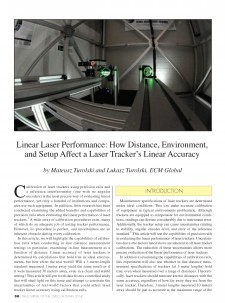
|
Download Members: $0.00 Non‑Members: $75.00 |
Buy Now |
Publication Details
| Published Date: | |
|---|---|
| Authors: | Mateusz Turolski, Lukasz Turolski |
| Company: | CMSC |
| Print Format: | Technical Paper |
| Citation: | Mateusz Turolski, Lukasz Turolski, "Linear Laser Performance: How Distance, Environment, and Setup Affect a Laser Tracker’s Linear Accuracy," The Journal of the CMSC, Vol. 9, No. 2, Autumn 2014 |
Abstract
Calibration of laser trackers using precision rails and a reference interferometer (one with no angular encoders) is the most precise way of evaluating linear performance, yet only a handful of institutions and companies use such equipment. In addition, little research has been conducted examining the added benefits and capabilities of precision rails when evaluating the linear performance of laser trackers. A wide array of calibration procedures exist, many of which do an adequate job of testing tracker performance. However, no procedure is perfect, and uncertainties are an inherent obstacle during every calibration. In this article, we will highlight the capabilities of calibration rails when conducting in-line distance measurement testing, in particular, by examining in-line measurement as a function of distance. Linear accuracy of laser trackers is determined by calculations that hold true in ideal environments, but how about the real world? Will a 3-m-length standard measured 1 m away yield the same result as if it were measured 30 m away, even in a clean and stable setting? This article will put forth data from a controlled study that will shed light on this issue and attempt to constrain the uncertainties of real-world factors that could affect laser tracker linear accuracy using calibration rails.







